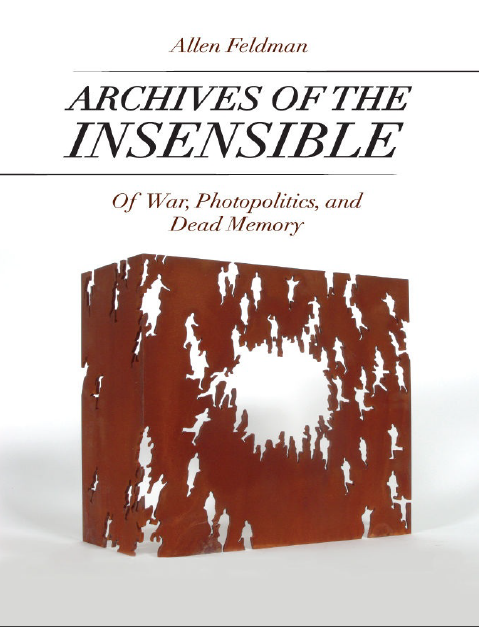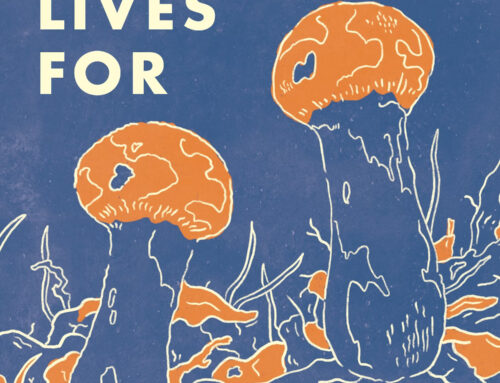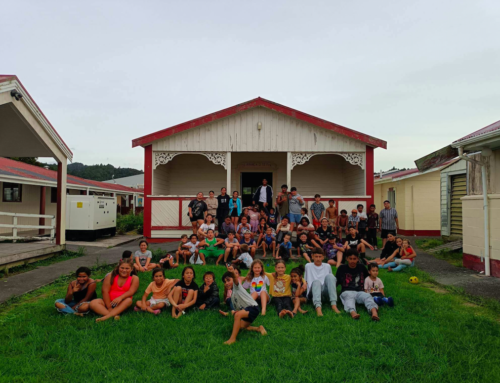by John F. Collins and Allen Feldman
AES is pleased to share this interview celebrating our 25th anniversary American Ethnologist article from 1994. John F. Collins, professor of anthropology at Queens College and the Graduate Center at CUNY interviews Allen Feldman, professor of media, culture, and communication at NYU about his article “On Cultural Anesthesia: From Desert Storm to Rodney King.”
This interview explores the relationship between ethnography and theory, descriptive adequacy, the weaponization of language, “shooting blanks,” algorithmic racism and the continuing photopolitics of cultural anesthesia.

Allen Feldman’s latest book, Archives of the Insensible: Of War, Photopolitics, and Dead Memory
John Collins: Allen, I’ve long appreciated the extent to which your ethnography is densely textual and responsive to continental philosophy while at the same time so visceral and even intimate, often in ways that exceed or force readers beyond what anthropologists typically understand as theory. It suggests the impossibility of separating theory and ethnographic description, or of assuming that theory is not affective, even as it draws readers’ attention to partition and segmentation, to unexpected correspondences or subterranean attunements, and thus to forms of resistance and identification and their violent negation. These are issues central to “On Cultural Anesthesia: From Desert Storm to Rodney King.” published just over twenty-five years ago, as well as to our present moment in the U.S.A., to the Northern Ireland you described in Formations of Violence (1991), and to the Guantanamo prison, U.S. biometric falsification in Afghanistan, and South African truth commission analyzed in your recent Archives of the Insensible (2015). So could you begin by giving us some idea of how you arrived at “cultural anesthesia”?
Allen Feldman: I will try to address the multifarious layers of your prelude. Dell Hymes wrote of descriptive adequacy in ethnography. For Hymes, this adequacy was not a warrant for definitive realism or sociological totalization. Like Hymes, I am critical of a descriptivism that disavows any theoretical mediation and presupposes linguistic transparency, a nonexistent “language of everyone,” and the immediacy of an ethnographic present under the guise of anti-theory and “commonsense.” The theoretical can encompasses the invention of a lexical “dialect” by responding to ethnographic particularities. I view description as theory incarnate and theory as both descriptive and dramaturgical. I “ethnographicize” political philosophy and philosophize ethnographic contingency. Even beyond fieldwork inquiry I gravitate to micrological descriptions of site-specific intensive totalities as pioneered by the urban physiognomies of Kracauer (1995).The disturbingly dense textuality you identify emerges from my tampering with language. I tamper because I remain dissatisfied with the inherited lexicon of political violence in the social sciences and our public culture. My dissatisfaction extends to the moralized and medicalized imperative in the social sciences: that in order to write violence one is expected to prescribe a cure for its pathology. To write violence without this subtext is to be condemned by the iconoclasts of violence in academia. The iconoclasts invoke the unwritten ban against the imaging and imagining of violence without provisioning the reader with the immunizing cordon sanitaire of a therapeutic resolution. Ekphrasis, the ancient art of imagining and describing what is not immediately before the senses, is embargoed by this iconoclasm. The iconoclasts have indicted me for aestheticizing violence. Yet, I map systematically how executive power is reliant on an aesthetics and sensorium of force comprised of tactical aesthesis and anesthesia. These critics never offer what their anti-aesthetic approach to violence might be; is it statistics, journalism, literature, medicalization, empiricist positivism? All these genres can be recast in terms of an aesthetics that gives textual pleasure in not giving pain. The iconoclasts ultimately recoil against the intimacy embedded in the ethnographic encounter with radical alterity, which informed my writing of the King crime scenes (his beating and the trial) though no ethnographic encounter was involved.
The aesthetic of narrative linearity, from symptom to pathology to reassuring prescription, conflates the writing of violence with mastery over violence. Judith Butler once asked Giorgio Agamben could he have prescribed the death sentence for Eichmann, as did Hannah Arendt. His loaded reply: “Who am I to give death sentences.” Similarly, I write violence, but not sentences of death; I am no master of violence. Writing violence is shooting blanks. Writing war makes nothing happens—it survives in the furrows of its own making. Shooting blanks also targets the blank sectors of executive power; the occlusions, blind-spots, redactions and remotions such as the disavowals of “collateral damage,” and other negative spaces that lubricate the impunity of war machines.
In reference to “continental” political theory there is a crucial distinction that is linguistically absent or blurred in the anglophone anthropology-sociology of power; the delineation of potestas (constituted power) and potentia (constitutive power) that was evident in Northern Irish warfare and that was also in play in the trial of the police who beat King. Walter Benjamin (1996) stressed that policing invariably blurs the border between law-conserving violence (potestas) and law-making violence (potentia). I do not assume the violence of jus-ad-bellum (justified war) or “reasonable use of force” are solely constituted by sovereign right or potestas; they can mutate into constitutive power with no principial ground. Potentia conjugates the sovereign right-to-be-without-right in inflicting violence and terror. The right-to-be-without-right oscillates between law-making and law-conserving trajectories. A law-making violence such as extra-judicial racialized killings by the police or vigilantes cuts away normative legal ground prior to being retroactively juridified and indemnified—brought into law—as in the cases of Tanisha Anderson, Michael Brown, Miriam Carey, Philando Castile, Shantel Davis, Amadou Diallo, Shelly Frey, Eric Garner, Darnisha Harris, Trayvon Martin, Yvette Smith, and many others.
In Northern Ireland I collided with the void between jus ad bellum as potestas and the hyper-performatives of material force as potentia in oral histories of police torture and Republican prisoner’s hunger strikes. I theorized the enforced ellipses between the sanitized aphorisms of just war and in the in-situ murk of material enactment. As the latter escalate the former becomes descriptively inadequate and incoherent concerning its means and ends. How to adequately describe the materiality of designed descriptive inadequacy and insensibility in political violence is my task. In the never-ending war on terror this void unfolds between the phantasmagoria of securitization and the disembodiments of “collateral damage.” I have recently written comparatively of enforced disappearance in apartheid South Africa and post-war Sri Lanka, wherein executive power disavows its disapparition of its citizens (2019a). This disappearance of disappearance is the camouflaging accidentalization of war also exemplified by the collateral damage doctrine. Accidentalization does not refer to war as inconvenienced by clusterfuck or blow-back, rather it infers design—the needful accident as war by other means. Numerous American juries have accidentalized racialized police and vigilante homicide; collateral damage is intrinsic to the visual, economic, political and legal culture of American racism from New Orleans under Hurricane Katrina to the toxic water infrastructure of Flint, Michigan.
My ethnographic encounter with counterinsurgent policing and carceral power in Northern Ireland initially positioned my reading of the King beating trial, and subsequently, apartheid era policing in South Africa, the Combatant Status Review Trials at Guantanamo prison, U.S. army kill teams in Afghanistan, policing the NYC unhoused with compromised immune systems, algorithmic warfare, and camouflaged regimes of enforced disappearance in South Africa and Sri Lanka. I have mapped power and privation across embodiment, spatiality, and visuality (2001; 2019b). I sought to understand how these mediologies underwrite, convey, and implant truth effects that splinter off artificed factuality from disavowed “surplus” actualities in order to render violence just. In Archives of the Insensible, I posit war as a regime of truth claiming and truth claiming as modes of war in which the human body is conscripted as a site of veridiction through its destructibility.
JC: That seems especially pertinent to the U.S.A. today, as well as to what you describe in relation to the body of Rodney King. Yet in “Cultural Anesthesia” you demonstrate the production of a certain coherence in relation to incoherence; or an incoherence that is then covered up by trials, by abbreviated searches for evidence, and by rationalizations that denigrate.
AF: Evidentiary “coherence” fabricated by videographic ellipses reframed King’s beating as his aggression. I call this dynamic photopolitics in Archives of the Insensible. The photopolitics of cultural anesthesia enforces the inadmissibility of heteronomous sensory capacities, histories and memory as stratified by race, gender, class, religion, sexual-gender orientation, immune status, nationality, and speciation. In King’s case this entailed the removal of his voice, pain and fear through the videographic dissection of his body. The photopolitical is comprised of phos and aphos, light and non-light, apparition and disapparition, screening as showing and screening as occlusion. Derrida (1973) writes of the “ancient clandestine friendship between light (lumiere) and power (puissance), the ancient complicity between theoretical objectivity and techno-political possession”—forces that were at play in the King beating trial. Nonlight (aphos) is as much a constitutive practice of power and privation as is light. Nonlight is not darkness, which infers photosensitivity, but anesthesia, insensibility and apperception. To approach violence as a photopolitics is to confront the trajectories of nonlight within light—the supernumerary forces of apperception and anesthesia that underwrite the officiating passages of light that articulate law, right, truth, and fact through the sacrificial occlusion of disavowed material actualities. The critique of photopolitics, whether it be police manipulation of the King beating video or drone omnivoyance, is not a disalienating return to light—transparency and disclosure—from a veiling occlusion. To propose a disjuncture between factuality (e.g., the juridical indemnification of police violence) and actuality (extra-judicial and racialized use-of-force) is not to arrive at an uncontestable ground behind masking ideologies, but to explore that groundless abyss itself as driving constitutive, autopoetic power. For example, to comprehend enforced disappearance as constitutive power is to step back from the human rights-NGO optics of showing and shaming, reliant on the Enlightenment equation of truth with light which has proved ineffective. Rather, I consider the making of the missing and the disappearance of their disappearance as a formative metaphysics of executive power. As with Rodney King’s humanity, pain and fear, the disappeared and the event of their abduction are placed under erasure by anesthesiological power.
JC: Could you say more about visuality and cultural anesthesia, and what that has led you to explore more recently?
AF: The admissibility of the manipulated video as raw evidence contaminated the evidentiary chain of the trial. It is also worth noting in retrospect that the police’s reversioning of the video foreshadowed contemporary machinic-algorithmic optics. King’s amputated videographic gestures were programmed into 1/0 binaries of law/nonlaw that instated the optical immunity and faux-objectivity of police violence. A counterfeit forensics was fashioned through elliptical frames, chronometric grids, and videographic topology of simulacral violence. Political topology is concerned with how bodies, discourses, and spaces are to be stitched together and the political connectivity arising from these arrangements. The police gaze was desubjectivized through its grafting onto the “reverse time axis” of a cinematic archive that disassembled, reassembled, and compressed King into proto-pixelated bits of impending violence.I have recently updated this inquiry into the technological automatism of law, violence, and racialized visual culture. “On Cultural Anesthesia” captured a historical juncture between American lawfare and warfare by analogizing the sensorial deletions of the King video to the scopic anesthesiology of Gulf War I smart bombs. These machines subtracted all other sensory channels in privileging the visual through preemption of the soundscapes, haptics, and odor of their destroyed targets in which human casualties never appeared. Harun Farocki (2004) also discerned optical desubjectivation in the machinic gaze transmitted by these descending ballistical cameras. For Farocki these “operative images” constitute “the unconscious visible”—a desubjectified optics generated through an a-signifying apparatus whose image production does not originate in, nor require, human consciousness, intentionality, or a point of view to generate evidentiary legibility. This is the technological precondition of algorithmic omnivoyance such as drone warfare and surveillance by metadata that I call the pointless view (2019b). Farocki’s automated “unconscious visible” is applicable to the cultural retentions and recursions of slavocratic racism. White public space is Farocki’s “unconscious visible,” a fetishized scanscape, through which a pre-comprehended collectivity of color attains deforming and traumatizing prosecutory visibility within a figure-ground surveillance grid. This apparatus automates Frank Wilderson’s “constitutive vertigo” of the black subject (2011). For Fanon the racialized abject is a space within visibility, a function derived from the unconscious visibility of white public space (1986). Cultural anesthesia proposes that racialized police violence mediates the reproduction of white public space through the destructible black body.
I am now working on a media archeology of slavocratic cultural retentions and recursivity that historically underwrite a political genealogy of techne. Consider the infrastructural import of the Roman designation of the slave as “instrumentum vocale”—a speaking instrument. This designation is a crucial archeological strata embedded in the subsequent intertwining of race, slavocratic power, mediology, and technology. In 5th century “democratic” Athens, slaves were juridically tortured to generate testimonial court evidence as torture of citizens was prohibited. The assemblage of torture, a subjugated body, the enslaved voice, and a legal archive constituted a material infrastructure of law that remains with us today in the encrypted retentions of white public space.
References:
Benjamin, Walter. 1996. “Critique of Violence.” In Selected Writings, 1913-1926, Volume I, edited by Marcus Bullock and Michael W. Jennings, Cambridge: Harvard Belknap Press.
Derrida, Jacques. 1973. Writing and Difference. Translated and edited by Alan Bass, New York: Routledge: 113.
Fanon, Franz. 1986. Black Skins, White Masks. London: Pluto Press.
Farocki, Harun. 2004. “Phantom Images.” PUBLIC 29: 12-22.
Feldman, Allen. 1991. Formations of Violence: the Narrative of the Body and Political Terror in Northern Ireland. Chicago: The University of Chicago Press.
—–. 2001. “Philoctetes Revisited: White Public Space, HIV, Homelessness and the Political Geography of Public Safety.” Social Text 68, 19(3): 58-89.
—–. 2015. Archives of the Insensible: of War, Photopolitics and Dead Memory, Chicago: The University of Chicago Press.
—–. 2019a. “War Under Erasure: Contretemps, Disappearance, Anthropophagy, Survivance.” Theory and Event 22(1): 175-203.
—–. 2019b. “From Ecotechnolgical War to the Echotheology of Omnvoyant Power.” In War and Algorithim, edited by M. Liljefors, D. Steur, G. Noll, London: Rowman and Littlefield.
Kracauer, Siegfried. 1995. The Mass Ornament: Weimer Essays. Edited and translated by Thomas Y., Cambridge, Massachusetts: Harvard University Press.
Wilderson III, Frank B. 2011. “The Vengeance of Vertigo: Aphasia and Abjection in the Trials of Black Insurgents.” Tensions 5 (Fall-Winter): 2: 1-41.
Cite as: John F. Collins and Allen Feldman. 2020. “The 25th Anniversary of “On Cultural Anesthesia: From Desert Storm to Rodney King.” American Ethnologist website, APRIL 25 2020 [https://americanethnologist.org/features/interviews/the-25th-anniversary-of-on-cultural-anesthesia-from-desert-storm-to-rodney-king]




